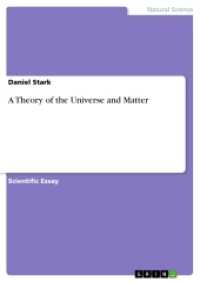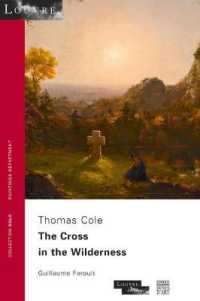- ホーム
- > 洋書
- > 英文書
- > Science / Mathematics
Full Description
Planet Earth has been a familiar concept for a mere fraction of recorded history. Until about the mid-1600s, most humans thought of Earth as immobile, likely either dim or simply invisible from the Moon or anywhere else in the heavens, and not (like the planets) participating in what Galileo called "the dance of the stars."
A Universe of Earths: Our Planet and Other Worlds, from Copernicus to NASA retraces the exhilarating story of how all that changed, and how we came to perceive the Earth as a "wandering star." It's a story that has vastly augmented and enriched our understanding of how Earth and its inhabitants fit into the big picture of the Cosmos.
But almost as soon as humans started to grasp that Earth is a planet, many also began wondering if perhaps the other planets might be earths. This bold conjecture ignited the whole gripping history and literature of space travel, of extraterrestrials, of other worlds. And yet the thesis that the Universe is full of other worlds like Earth has from the start been fuelled more by imagination than by scientific evidence. For all its appeal, it has consistently been undermined by observations of the actual Universe.
A Universe of Earths offers a surprising alternative to that "other worlds" account, one that releases humans not only from the pre-Copernican view of Earth as low, lowly, dark, a cosmic sump, but also from the persistent modern aspersion of Earth as cosmically ordinary, "mediocre," "dethroned." Instead, from Copernicus to the present, we are confronted with the bracing realization that Earth is in the classical sense a star, a dynamically wandering one, and a bright, maybe even peerless participant in the dance of the stars.
Contents
1: Prologue: Discerning the Cosmos
2: Copernicus's Giant Leap
3: "Little Dark Star"
4: Galileo: "Dance of the Stars"
5: "Nest of Angels": Early Modern Extraterrestrials
6: Star Amid the Darkness
7: The Great Copernican Cliché
8: The Case Against Copernicus
9: Dethroning the Sun
10: "Reasoning by Analogy": Earths, Suns, Galaxies
11: The Problem of Life
12: Cold, Dark Night in a Universe of Galaxies
13: "Variety Enormously Greater than Had Been Supposed"
14: Junctions on the Road to Star Wars
15: Searching for Intelligent Extraterrestrials
16: "An Awful Waste of Space"
17: "Inevitably Privileged to Some Extent"
18: A Precious Planet Earth
Works Cited
Acknowledgments








